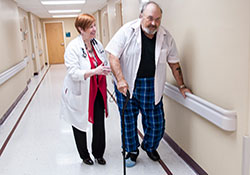Office of Research & Development |
 |
Office of Research & Development |
 |

VA Research Currents archive
Posted July 16, 2013
(Summer 2013 VA Research Currents)

Veteran George Murphy of Pinson, Ala.,
is guided by Dr. Cynthia J. Brown as he
participates in a fall-prevention clinic at the
Birmingham VA Medical Center. (Photo by Joseph De Sciose)
Related article: Researchers study the effects of low mobility on older hospital patients-and seek ways to get them moving more
Dr. Cynthia J. Brown wanted to prove her skeptics wrong when she launched a study of a walking intervention a couple of years ago.
"I have heard—till I'm blue in the face from trying to hold it in and not get mad at people—�You're going to make them fall. You can't let them out of bed.' That's why we did the study."
The trial included 100 older inpatients at the Birmingham VA Medical Center. The Veterans were randomized to one of two groups:
The results aren't published yet, but Brown shares that "we showed it was feasible. We were able to motivate people and convince them to walk in the hospital. We also showed it was safe. In terms of falls, which was everyone's concern, there were a total of three falls, in two patients, and they were both in the usual-care group."
In other words, prodding patients to walk, and getting them excited about doing so, did not increase their risk of falling. As Brown had confidently predicted, those fears did not materialize.
The researchers also found that in the month after discharge, those who had been in the intervention group had less difficulty getting around their communities.
Another lesson gleaned from the study may be especially relevant for today's economic times: In most cases, it doesn't take a trained health professional to assist an older patient with walking. "It doesn't even have to be a hospital employee at all," notes Brown. "It could be a volunteer or a family member."
She notes that some instances require extra caution—for example, a patient who is very heavy, trying to walk aided by his 100-pound spouse. But in general, she says, "Families want to help—they just need to know what they can do. We need to do a better job of communicating that to them."